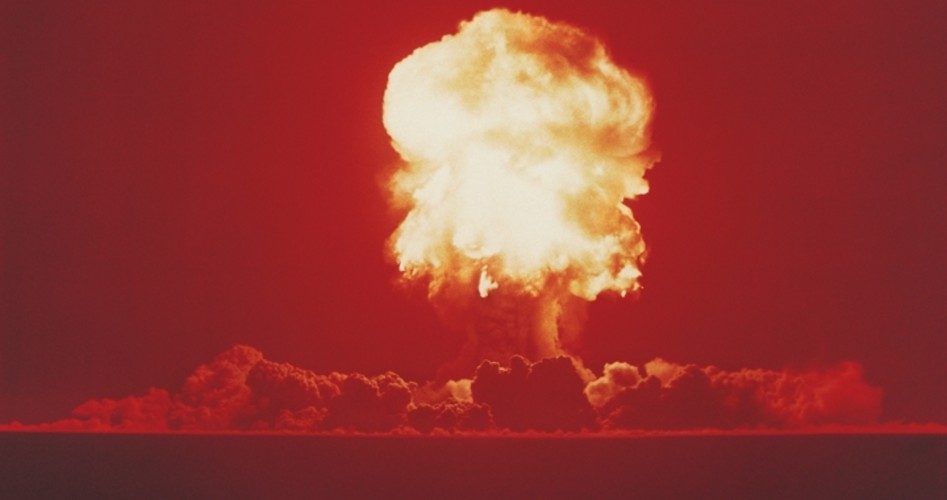
Running out of both time and patience with Democrat obstructionism in confirming some 130 of President Trump’s judicial appointees, Republican Majority Leader Mitch McConnell invoked the “nuclear option” on Wednesday. The phrase “nuclear option” was first used by Republican Senator Trent Lott in March 2003 to describe the change in the Senate parliamentary procedure that now limits confirmation debate on judicial and executive branch nominees to just two hours, down from the previous 30. It still leaves appointees to the Supreme Court to face 30 hours of debate over their nominations. It also requires a simple majority to confirm, down from three-fifths previously.
Democrats have used and abused the privilege to stall, stymie, delay, and slow-walk Trump’s nominees as part of their overall plan to keep him from implementing policies that threaten their agenda.
Senate Minority Leader Chuck Schumer (D-N.Y.) feigned outrage: “This is a very sad day for the Senate. The majority, by taking yet another step to erode [its] legacy, risks turning this body into a colosseum of zero-sum infighting, a place where the brute power of the majority ultimately rules.”
McConnell charged:
He started this whole thing. This is not a sad day. This is a glad day. This is a day we end this completely outrageous level of interference and obstruction with this administration….
It’s time for this sorry chapter to end. It’s time to return this body to a more normal and reasonable process for fulfilling its constitutional responsibilities no matter which party controls the White House. This [obstruction by Democrats] is new. And it needs to stop.
In reality it was former Senate Majority Leader Harry Reid (D-Nev.) who “started the whole thing” back in 2013. With the Senate then in Democrat hands, Republicans used the filibuster to delay confirmation of three appointees by President Obama to the U.S. Court of Appeals for the District of Columbia. At that moment in time there were 59 executive branch nominees and 17 judicial nominees waiting in the queue for Senate confirmation.
In 2017 McConnell invoked the nuclear option to kill the 60-vote requirement still remaining on Supreme Court nominees. This ended debate over the nomination of Neil Gorsuch to the high court and allowed the Senate to confirm it.
The Constitution left the question open. It addressed the process of confirmation in two places: Article I, Section V, and Article II, Section 2, paragraph 2. The first permits each house of Congress to establish its own rules; the second provides that “the President … shall nominate … by and with the Advice and Consent of the Senate … Judges of the Supreme Court and all other Officers of the United States.” Nothing was said about how many senators needed to give their consent. It was left up to the Senate to determine the rules.
The history of confirmation is checkered but remained relatively stable until 2013. When Reid invoked the nuclear option, he opened the door for McConnell. That’s one of the reasons that Senator Mike Lee (R-Utah) voted against it, stating, “I worry that we might be accelerating our march towards [more dramatic changes]. One reason they call this the nuclear option is once it’s set in motion, it can be difficult to control.”
Under the new/old rule, confirmation of appointees requires a simple majority instead of three-fifths before McConnell invoked the nuclear option. With more than 130 Trump appointees waiting in line, McConnell — who has made no secret of his desire to get as many of them confirmed as rapidly as possible — hopes to empty the pipeline before the 2020 elections.
The “nuclear option” all but ensures President Donald Trump’s legacy in shaping the judicial landscape of the American republic for decades to come. While most are focusing attention on the health of aging left-liberal Supreme Court Justice Ruth Bader Ginsburg (she turned 86 in March) and Trump’s plans to nominate U.S. Circuit Judge Amy Barrett (age 47) to replace her, the Supreme Court takes under review very few cases. Most of the heavy lifting, and the welcome restoration of original intent of the Founders, takes place in lower courts.
This, of course, is the reason for the Democrat obstructionism. They see the very real danger of decades of their efforts to move the United States’ ship of state to the left being slowed and possibly being reversed.
What is ironic is that the tool McConnell is using to ensure Trump’s legacy was provided by the Democrats.
An Ivy League graduate and former investment advisor, Bob is a regular contributor to The New American, writing primarily on economics and politics. He can be reached at [email protected].



